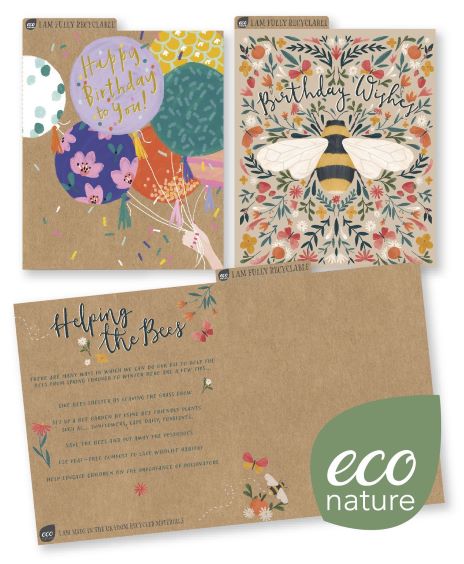
The importance of living and working in a sustainable way, and reducing our environment impact, is key in the battle to combat climate change and ensure our planet is fit for our children and grandchildren.
Consumers are increasingly aware of this as they shop; choices they make in their their daily lives reflect this. Young card senders (Gen Z, the volume consumers of tomorrow), are particularly aware of issues relating to the environment.
87% of Gen Z are worried about the environment and the planet, they will carry their passionate beliefs with them as they grow into their peak spending years.
Source: WGSN by Ascential
73% of Gen Z are prepared to spend more for sustainable products, more than any other generation.
Source: WGSN by Ascential
GCA vice-president, and UKG commercial director, Darren Cave is a member of the GCA Council’s sustainability sub-committee, working to support the industry on the journey to continue to reduce our environmental footprint.
This blog is an overview of the current state of play, the different elements of greeting cards affected and suggestions as to how to embrace the circular model, extending the life of our precious resources.
The GCA will continue to update this information to support you as you make decisions for your business.
GCA support for sustainability in the card industry
The greeting card industry has made significant progress to date, with businesses working on all aspects of their business process and product development to reduce their environmental footprint. One noticeable area is that of wrapped cards – it’s estimated that as an industry we’ve moved from 2/3 wrapped to 2/3 unwrapped; from 65% to only 15% now wrapped.
The GCA recognises that the greeting card industry needs to be able to demonstrate that it is taking its environmental responsibilities seriously and that it is doing its utmost to face its responsibilities. To support the industry the GCA will continue to share good practice, information and changes in law to help members navigate this road and support them to reduce their environmental footprint.
Darren Cave continues “The GCA recognizes these shifting attitudes and its role in helping to protect the environment for future generations. We’re committed to supporting an increasingly sustainable greeting card industry”.
Raw Materials
Paper/Board – Timber Based

Our industry does its utmost to ensure that no greeting cards are printed on material sourced via illegal logging. Illegal logging and related trade occurs when timber is harvested, transported, processed, bought or sold in violation of national or sub-national laws. It can also happen when forests are cleared for plantations such as oil palm. Illegal logging exists because of increasing demand for timber, paper and derivative products, including packaging. According to WWF “Illegal logging accounts for 50-90% of all forestry activities in key producer tropical forests, such as those of the Amazon Basin, Central Africa and Southeast Asia, and 15-30% of all wood traded globally*”.
Most publishers now stipulate that all paper used in the production of greeting cards is sourced from managed sustainable forestry certified to FSC® (Forest Stewardship Council) or PEFC (Programme for the Endorsement of Forest Certification), the highest chain of custody standards. These standards promote responsible management of the world’s forests.
The GCA and the FSC®
The Forest Stewardship Council® (FSC®) is an international, non-governmental organisation dedicated to promoting responsible management of the world’s forests. FSC has grown to become the world’s most respected and widespread forest certification system.
FSC’s pioneering certification system, which now covers more than 200 million hectares of forest, enables businesses and consumers to choose wood, paper and other forest products that support responsible forestry.
The GCA works closely with the FSC. Please see our comprehensive blog FSC and Greeting Cards for more information on FSC and how you can use their widely recognised logo on your cards.
GCA Recommendation
Ensure that your cards have the FSC® logo printed on the back to demonstrate that your cards are printed on certified board. Specialist greeting card printers will be able to advice you on this.
Paper/Board – Recycled Fibres
New board innovations are constantly coming onto the market, including a board upcycled from used coffee cups. The use of recycled content board reduces the reliance on virgin materials, embracing the circular model. However, without new virgin fibres from trees, the paper cycle cannot be maintained. Recycled fibres degrade after several uses and the paper industry needs fresh fibre from sustainably managed forests to keep the renewable cycle going.
GCA Recommendation
Consider the introduction of recycled content board in order to reduce reliance on virgin sources.
Paper/Board – Alternative Fibres
Most UK paper mills are set up to reprocess cellulose fibre derived from trees. The recycling industry acknowledges that there is increasing pressure to use alternative fibre sources, particularly those derived from agricultural residues. Bagasse, Palm fibre, rice straw, Wheat straw, Barley Straw, Oat Straw, and other plant fibres. Subject to fibre having been prepared for use in papermaking and presented in a form suitable to be recognised in the papermaking process, these fibres can be recycled. However, the Paper Industry recognises the urgent need to investigate the impact of these fibres when they are returned into a conventional papermaking process. The varying properties of alternative fibres could mean they will be separated out in the process at the mill and may be discarded in the waste stream.*
* source: CPI: Paper and Board Packaging Recyclability Guidelines January 2020.
GCA Recommendation
Approach with caution when considering alternative fibres. This is in order to ensure that the material remains recyclable. Speak to your printer and the specialist paper and board suppliers that work within our industry.
The Importance of Sustainable Forestry
Forests are one of the world’s most valuable resources and home to more than half the world’s land-based animal and plant species.
Over the past four decades they have moderated global warming by absorbing around 1/4 of the carbon dioxide emitted by human activities. Carbon sequestration in forests reduces the rate of carbon accumulation in the atmosphere and so reduces the rate of climate change.
Forests are an extremely important part of the environment. Well managed sustainable forests give multiple benefits to society, such as supporting livelihoods, ecosystem services and biodiversity, whilst also helping to tackle climate change. To ensure the long-term health of forests, sustainable forest management underpins how the paper industry operates and sources its main raw material.
Paper is based on wood, and natural and renewable material. Paper is one of the most recycled products in the world and epitomizes the circular economy model of make, use, recycle and reuse.
Production
The greeting card industry works with specialist print suppliers , these have FSC® certification and work to the highest environmental standards.
Flitter and Glitter

A major piece of research by the University of Plymouth has confirmed that no trace of any particle of glitter from a greeting card has been found in the oceans around the UK
However, from a recycling perspective glitter passes into the finished product, causing imperfections in the finished product and causing paper to be unprintable. The use of glitter and flitter will compromise the product’s recyclability, and current recommendations from the Recycle Now website are are that “embellishments such as ribbons or glitter [are removed] before recycling”
Foiling

Greeting cards with foil are generally recyclable, so can be put either in recycling bins or at depots. During recycling the cards are pulped, the foil is separated by floating off and then dried and sent to incineration. Hot and Cold Foil Transfer can be dealt with by paper mills. Cartons printed with not more than 60% of the external surface area in foil transfer should be considered recyclable. * source: CPI: Paper and Board Packaging Recyclability Guidelines January 2020.
Manufacturing waste: excess foils used in manufacturing process are either used as fuel via incineration or used for animal bedding i.e. strips of foil that are left on the reel.
UV Inks and Varnishes
UV inks and varnishes can cause issues within some papermaking processes, as they are not readily removed by most conventional de-inking technology. Where they are used they can cause flecking on the new paper sheet. For this reason, the paper recycling industry would prefer to keep to a minimum the quantities of cured varnished material (either conventional or UV cured) specified in packaging products.
* source: CPI: Paper and Board Packaging Recyclability Guidelines January 2020.
GCA Recommendation
UV inks and varnishes can be recycled but are least preferred by the paper recycling industry; whereas water-based is most preferred.
Attachments
The recyclability of the greeting card is compromised when it is embellished with non-paper attachments. For instance, gems, nylon ribbon and foam pads, are all plastic based.
GCA Recommendation
Review your approach to the design and specification of attachments where a sustainable paper-based approach is preferred.
Recycling
WRAP is the body responsible for government and local council advice on waste and recycling. The advice on WRAP’s Recycle Now website is that cards and envelopes can be recycled either via kerbside collections or local depots, with the caveat that attachments and glitter/flittered surfaces should be removed.
WRAP has a number of logos which can be printed on other products and can be downloaded from its library. It is free to join WRAP as a partner and use their logos.

This WRAP recycling logo is available free of charge and can be downloaded here. When using this logo, please be aware of the following caveats and if necessary use the following relevant wording: ‘Please remove (attachments)(glittered areas)(laminated areas)(badges) which are unsuitable for recycling.’ There are other logos available, and some publisher have designed their own.
Packaging
Plastics Legislation

While plastic has many valuable uses, society has become addicted to single-use plastic products — with severe environmental, social, economic and health consequences.
Around the world, one million plastic bottles are purchased every minute, while up to five trillion plastic bags are used worldwide every year. In total, half of all plastic produced is designed for single-use purposes – used just once and then thrown away.
The acceleration of global regulations targeting plastic-packaging waste may increase risks for the plastic-packaging producers. These risks could range from taxes on product sales to financial liabilities, as well as market-share losses for companies that cannot meet requirements. However, the regulatory pressure may also offer opportunities for companies that are well positioned for a circular economy transition.
The UK Government introduced the plastic packaging tax on 1 April 2022, which is designed to give companies a financial incentive to meet worldwide environmental targets. UK manufacturers and importers of over 10 tonnes of plastic packaging a year will need to pay the new tax of GBP200 per tonne. This applies to any plastic packaging with under 30% recycled content.
Applicable publishers must also keep an eye on the Extended Producer Responsibility (EPR) for packaging. The regulations will apply to all UK organisations that handle and supply packaging. You must take action to collect the correct data from 1st January 2023.
You must take action to comply if all the following apply:
- you’re an individual business, subsidiary or group (but not a charity)
- you have an annual turnover of £1 million or more (based on your most recent annual accounts)
- you’re responsible for over 25 tonnes of packaging in a calendar year (January to December)
- you carry out any of the packaging activities listed is a system whereby the full costs associated with the environmental disposal of a product (or packaging) are met by the business placing that product (or packaging) on the market.
For packaging, this means a change from the current system of partial participation, to one of full net cost recovery.
Cello Wrap Bagging / Sleeving
There are now two key reasons why cards are sold wrapped – to protect the card and keep the card and envelope from being separated. Despite this, given the environmental impact of plastic, the industry has, in recent years, made significant strides in its endeavours to remove the use of cello-bagging. The GCA continues to support the transition to “Go Naked”.
GCA Recommendations
We would recommend that unless a card has attachments, or is especially delicate (e.g., laser cut, or 3D pop up), publishers and retailers should embrace selling cards unwrapped.
Where practicable publishers should review plastic packaging in the supply chain. The best approach is to remove it where possible, reduce it through re-design and considered material specifications. There is also the option to consider a transparent paper option.
Consider the introduction of recycled content. Remember to ensure circularity, the material should be recyclable at the end of its life.





